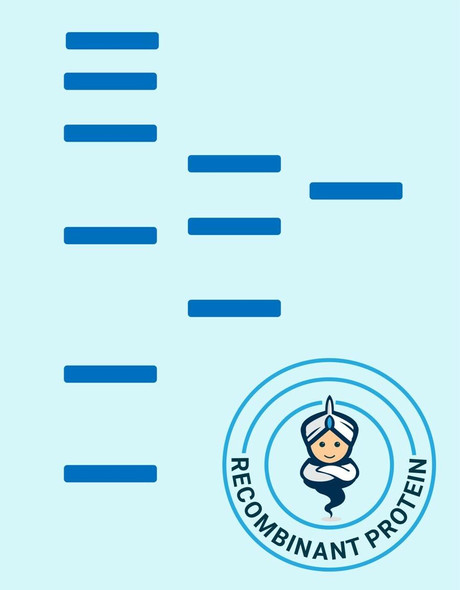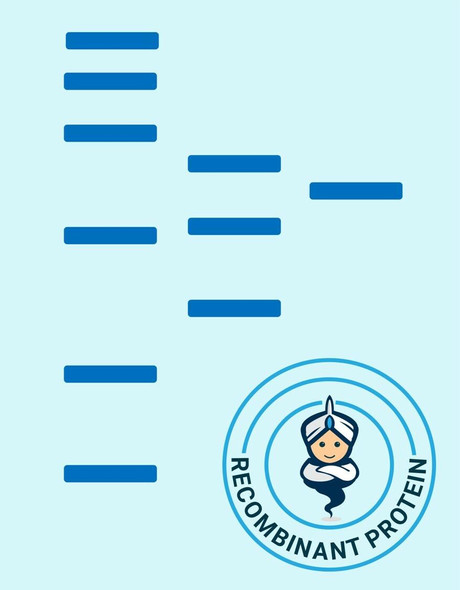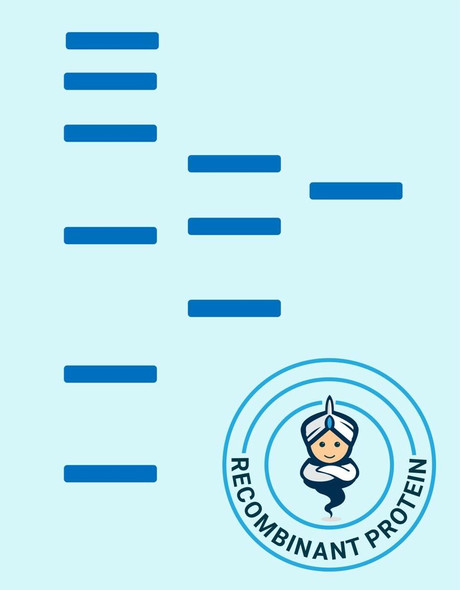Cytokines Recombinant Proteins
Mouse IL 6 Recombinant Protein (RPPB0527)
- SKU:
- RPPB0527
- Product Type:
- Recombinant Protein
- Species:
- Mouse
- Uniprot:
- P08505
- Research Area:
- Cytokines
Description
| Product Name: | Mouse IL 6 Recombinant Protein |
| Product Code: | RPPB0527 |
| Size: | 10µg |
| Species: | Mouse |
| Target: | IL 6 |
| Synonyms: | IFN-b2, B cell differentiation factor (BCDF), BSF-2, HPGF, HSF, MGI-2, IL-6, Interleukin HP-1, B-cell hybridoma growth factor. |
| Source: | Escherichia Coli |
| Physical Appearance: | Sterile Filtered White lyophilized (freeze-dried) powder. |
| Formulation: | Lyophilized from a 0.2�m filtered concentrated solution in PBS, pH 7.4. |
| Solubility: | It is recommended to reconstitute the lyophilized Mouse Il-6 in sterile 18M-cm H2O not less than 100�g/ml, which can then be further diluted to other aqueous solutions. |
| Stability: | Lyophilized Interleukin-6 although stable at room temperature for 3 weeks, should be stored desiccated below -18°C. Upon reconstitution IL6 should be stored at 4°C between 2-7 days and for future use below -18°C.For long term storage it is recommended to add a carrier protein (0.1% HSA or BSA).Please prevent freeze-thaw cycles. |
| Purity: | Greater than 96.0% as determined by: (a) Analysis by RP-HPLC. (b) Analysis by SDS-PAGE. |
| Amino Acid Sequence: | FPTSQVRRGD FTEDTTPNRP VYTTSQVGGL ITHVLWEIVE MRKELCNGNS DCMNNDDALA ENNLKLPEIQ RNDGCYQTGY NQEICLLKIS SGLLEYHSYL EYMKNNLKDN KKDKARVLQR DTETLIHIFN QEVKDLHKIV LPTPISNALL TDKLESQKEW LRTKTIQFIL KSLEEFLKVT LRSTRQT |
| Biological Activity: | The ED50 as determined by the dose-dependant stimulation of the proliferation of IL-6-dependent murine 7TD1 cells is < 0.02 ng/ml, corresponding to a specific activity of > 50,000,000 units/mg. |
Interleukin-6 is a potent pro-inflammatory cytokine primarily produced by activated T cells and an assortment of other cells including endothelial cells and macrophages. IL-6 affects B and T lymphocytes and has been shown to have a role in host defense, acute phase reactions, immune responses and hematopoiesis.
Interleukin-6 Mouse Recombinant produced in E.Coli is a single, non-glycosylated polypeptide chain containing 187 amino acids and having a molecular mass of 21709 Dalton. The IL-6 is purified by proprietary chromatographic techniques.
| UniProt Protein Function: | IL6: Cytokine with a wide variety of biological functions. It is a potent inducer of the acute phase response. Plays an essential role in the final differentiation of B-cells into Ig- secreting cells Involved in lymphocyte and monocyte differentiation. It induces myeloma and plasmacytoma growth and induces nerve cells differentiation Acts on B-cells, T-cells, hepatocytes, hematopoietic progenitor cells and cells of the CNS. Also acts as a myokine. It is discharged into the bloodstream after muscle contraction and acts to increase the breakdown of fats and to improve insulin resistance. Genetic variations in IL6 are associated with susceptibility to rheumatoid arthritis systemic juvenile (RASJ). An inflammatory articular disorder with systemic- onset beginning before the age of 16. It represents a subgroup of juvenile arthritis associated with severe extraarticular features and occasionally fatal complications. During active phases of the disorder, patients display a typical daily spiking fever, an evanescent macular rash, lymphadenopathy, hepatosplenomegaly, serositis, myalgia and arthritis. A IL6 promoter polymorphism is associated with a lifetime risk of development of Kaposi sarcoma in HIV-infected men. Belongs to the IL-6 superfamily. |
| UniProt Protein Details: | Protein type:Secreted, signal peptide; Secreted Cellular Component: extracellular space; cell; cytoplasm; extracellular region; interleukin-6 receptor complex; external side of plasma membrane Molecular Function:protein binding; interleukin-6 receptor binding; growth factor activity; cytokine activity; receptor binding Biological Process: positive regulation of nitric oxide biosynthetic process; positive regulation of apoptosis; negative regulation of collagen biosynthetic process; positive regulation of transcription, DNA-dependent; response to glucocorticoid stimulus; negative regulation of cytokine secretion; myeloid cell homeostasis; positive regulation of JAK-STAT cascade; glucose homeostasis; positive regulation of tyrosine phosphorylation of Stat3 protein; muscle maintenance; regulation of apoptosis; regulation of cell shape; positive regulation of T-helper 2 cell differentiation; positive regulation of acute inflammatory response; negative regulation of gluconeogenesis; acute-phase response; positive regulation of T cell proliferation; cell growth; defense response to virus; neurite development; positive regulation of protein import into nucleus, translocation; positive regulation of interleukin-6 production; defense response to protozoan; positive regulation of chemokine production; positive regulation of peptidyl-tyrosine phosphorylation; cell redox homeostasis; positive regulation of B cell activation; negative regulation of protein kinase activity; neutrophil apoptosis; positive regulation of transcription factor activity; positive regulation of transcription from RNA polymerase II promoter; positive regulation of epithelial cell proliferation; negative regulation of apoptosis; negative regulation of muscle development; T cell activation; positive regulation of translation; negative regulation of hormone secretion; positive regulation of smooth muscle cell proliferation; negative regulation of caspase activity; regulation of circadian sleep/wake cycle, non-REM sleep; negative regulation of cell proliferation; positive regulation of MAPKKK cascade; positive regulation of cell proliferation; response to wounding; hepatic immune response; inflammatory response; negative regulation of chemokine biosynthetic process; cytokine and chemokine mediated signaling pathway; positive regulation of immunoglobulin secretion; positive regulation of peptidyl-serine phosphorylation; endocrine pancreas development; regulation of cell proliferation; positive regulation of protein kinase B signaling cascade; immune response; positive regulation of neuron differentiation; positive regulation of DNA replication; positive regulation of transmission of nerve impulse |
| UniProt Code: | P08505 |
| NCBI GenInfo Identifier: | 124348 |
| NCBI Gene ID: | 16193 |
| NCBI Accession: | P08505.1 |
| UniProt Secondary Accession: | P08505,Q3UCQ0, Q8BN26, |
| UniProt Related Accession: | P08505 |
| Molecular Weight: | 24,384 Da |
| NCBI Full Name: | Interleukin-6 |
| NCBI Synonym Full Names: | interleukin 6 |
| NCBI Official Symbol: | Il6�� |
| NCBI Official Synonym Symbols: | Il-6�� |
| NCBI Protein Information: | interleukin-6; interleukin HP-1; B-cell hybridoma growth factor |
| UniProt Protein Name: | Interleukin-6 |
| UniProt Synonym Protein Names: | B-cell hybridoma growth factor; Interleukin HP-1 |
| Protein Family: | Interleukin |
| UniProt Gene Name: | Il6�� |
| UniProt Entry Name: | IL6_MOUSE |






